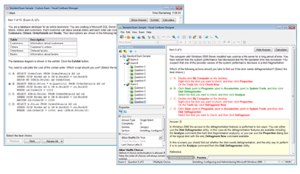eCommerce is a rapidly growing and ever-evolving industry, and having a deep understanding of the architecture of an eCommerce stack is crucial to success in the field.
The architecture of an eCommerce stack plays a key role in the overall performance and scalability of an online business. It is the combination of components, technologies, and services that make up the overall eCommerce system. The architecture of an eCommerce stack includes components such as the web server, database, cloud services, and payment gateway.

Each of these components plays an important role in the operation of an online store and must be configured correctly to ensure the store runs smoothly and efficiently. By understanding the headless commerce architecture of your tech stack, businesses can create a customized system to meet their specific needs, which can help to maximize their success.
Components of an eCommerce stack
Now that you have an understanding of the architecture of an eCommerce stack, let’s take a look at the individual components of the stack. Understanding the individual components of an eCommerce stack helps you to optimize your system and find ways to scale your business.
- Web server: The web server is the component that handles communication between the store and the users. It also provides analytics and user management services. A web server like Apache is a great choice for most eCommerce stores due to its high performance, security, and scalability. A web server like Apache can handle traffic on a large scale, has a built-in firewall, and can be configured in a modular way that makes it easy to scale the system.
- Database: The database stores all the product information, inventory information, and transaction data. It also stores settings related to security and performance. A database like Oracle can handle high loads and is secure, reliable, and scalable. A database like Oracle offers many benefits for eCommerce stores like storing large amounts of data, enabling a smooth shopping experience, and providing real-time data.
- Cloud services: The cloud services are provided by a third-party service provider and allow you to run your store on the cloud. These services include things like application deployment, security, monitoring, and scaling. A cloud service like Amazon Web Services offers a large range of services that can be integrated with your Oracle database, so read the documentation carefully to find the best options for your store.
- Payment gateway: The payment gateway handles payments on your behalf. It’s important to pick a payment gateway like Stripe that can accommodate high transaction volumes. A payment gateway like Stripe can process and authorize thousands of payments every day and has built-in fraud protection to help you avoid chargebacks.
Also Read: Modern Tech That’s Changing the Way We Work
Benefits of understanding the architecture of an eCommerce stack
Understanding the architecture of an eCommerce stack can help you to optimize your system and find ways to scale your business. Understanding the components of an eCommerce stack can help to avoid issues like poor performance, security breaches, and high maintenance costs. This is because the architecture of an eCommerce stack is closely linked to each other.
- Better performance – A scalable eCommerce stack will be able to handle high traffic volumes and ensure a smooth shopping experience for your customers. By understanding the architecture of an eCommerce stack, you can ensure that your website runs as smoothly as possible.
- Security – A secure eCommerce stack is essential for protecting your business. Understanding the architecture of an eCommerce stack can help you to improve security on your site by using strong encryption and authentication methods.
- High maintenance costs – Because the components of an eCommerce stack are closely linked, any issues in one area will affect the others. Knowing the architecture of an eCommerce stack will help to identify issues in one area and find solutions to fix them.
Creating a customized eCommerce system
Now that you have a good understanding of the components of an eCommerce stack, you can create a custom eCommerce system to suit your specific needs. The architecture of an eCommerce system is customized for your specific needs and is configured to meet your unique needs.
This can help to maximize your success by providing a tailored experience for your customers. A tailored eCommerce experience is one that is customized for the needs of your customers. This can include things like product search, categories, product filtering, product reviews, and product image search.
Tips for optimizing your eCommerce store
An eCommerce store is a great way to increase your business’s sales, reach, and overall visibility. With the right strategies in place, you can optimize your eCommerce store to maximize profits and customer satisfaction. Here are some tips to help you get started.
First, take advantage of composable trade. Composable trade is an innovative approach to eCommerce that allows you to build an online store that can be customized to meet specific customer needs.
By creating a composable trade model, you can create a store that can be easily modified to suit the needs of different customers. This will help you to quickly and easily adjust the store’s features and products to maximize profits and customer satisfaction.
Second, focus on the customer experience. Creating an engaging, user-friendly experience is essential to ensuring customer satisfaction.
From the moment a potential customer lands on your website, you should strive to provide a seamless experience that is tailored to the customer’s needs. This means creating an intuitive user interface, an easy checkout process, and helpful customer service.
Third, use data to your advantage. Your eCommerce store’s success will largely depend on the data it collects. With the right analytics tools in place, you can easily track the performance of your store and make informed decisions about how to optimize it.
This data can also be used to improve customer experience by suggesting products to customers based on their past purchases or interests.
Finally, make sure your store is mobile-friendly. As more and more customers are doing their shopping online, it’s important to make sure your eCommerce store is mobile-friendly. This means making sure your store’s design is responsive and optimized for the best experience on mobile devices.
By taking advantage of composable trade, focusing on the customer experience, using data to your advantage, and making sure your store is mobile-friendly, you can optimize your eCommerce store to maximize profits and customer satisfaction. With the right strategies in place, your store can become a successful, profitable venture.
Also Read: What Are Some Must-Have Android Apps?
Summary
An eCommerce stack is the combination of components, technologies, and services that make up the overall system. Understanding the architecture of an eCommerce stack can help you to choose the best components for your system and help to optimize the system for maximum performance.


